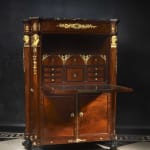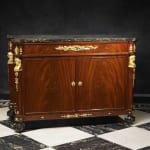Guillaume Benneman
The commode: Height 105 cm, width 90 cm, depth 55 cm.
Further images
An extremely important Empire mahogany secrétaire à abattant and matching commode, both with gilt bronze figural mounts to the fronts and back, original gilding, original keys and original marble tops, by Guillaume Benneman (m.1785, d.1811), both stamped with the maker's name
Paris, date circa 1800
The secrétaire: Height 140 cm, width 92 cm, depth 46 cm.
The commode: Height 105 cm, width 90 cm, depth 55 cm.
In 1785 Guillaume Benneman became a maître-ébéniste and was also appointed principal ébéniste to King Louis XVI. He made many fine pieces for the king, which were housed at Versailles, Fontainebleu, Saint-Cloud and other royal palaces. Benneman also supplied the nobility and aristocracy and after the overthrow of the king, once more rose to fame during Napoleon's rule. Although his birth date is unknown, we know that Benneman was born and trained in Germany, arriving in Paris relatively late in his career. The Garde-Meuble, who was responsible for furnishing the royal palaces, gave him the first of many commissions in 1784. Although Benneman never mastered the French language his native birth and training was to his advantage. French royalty and aristocracy had long admired other German-born ébénistes such as J-F. Oeben, M. Carlin, A. Weisweiler and J-H. Riesener, whom Benneman replaced as the Crown's chief furniture maker in 1785.
After his appointment, Benneman set up behind the Temple at 6 Rue Foret, where he was still working in 1804. The Crown officials gave him sufficient money to provide tools for nine craftsmen, by 1788 he had some twenty assistants. Among his royal commissions he made a number of alterations and reconstructions of earlier pieces including some by Joseph Stöckel. During the Revolution he was employed by the new Republican government to remove 'insignia of feudality' from existing royal pieces. Benneman rose once more under Napoleon, providing the latter with a number of fine pieces. The most notable were a beautiful commode and secrétaire for Château Fontainebleu, designed by Charles Percier (1764-1838). Benneman also made other Empire pieces to the designs of Percier.
Benneman's work is characterised by crisp lines decorated with the most elegant antique motifs such as Vitruvian scrolls, rope handles attached to Hercules' clubs, fluted panels and generally magnificent pillared corners headed by ornate caryatids. As was the practice, he collaborated with other craftsmen in the construction of the final work. They included some of the finest artists of the day notably the bronziers, Pierre-Philippe Thomire, André-Antoine Ravrio, Claude Galle and the Forestier brothers as well as the sculptors Louis-Simon Boizot and Martin. He also worked at times in association with other great ébénistes, notably Kemp and Weisweiler. Thus many of Benneman's great works also owe credit to other similarly famous artists. Benneman's work is prized among some of the finest collections of French furniture, notably at the Louvre, Paris; the J. Paul Getty Museum, Malibu; the Metropolitan Museum of Art, New York; the Hermitage, Leningrad; the Wallace Collection, London and Baron Rothschild's former home at Waddesdon Manor, Oxfordshire. Some pieces remain in private hands but they occasionally appear on the open market.









